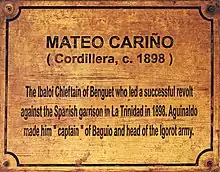Mateo Cariño
Mateo Cariño was an Ibaloi chieftain[2] who owned the land that was to become Baguio. He led a successful revolt against the Spanish garrison in La Trinidad and was proclaimed the Capitan Municipal of Baguio by President Emilio Aguinaldo.
Mateo Cariño | |
|---|---|
 Mateo Cariño monument at Rizal Park | |
| Born | 1841[1] |
| Died | 1908 |
| Occupation | Chieftain |
| Known for |
|
Background

He owned vast tracts of land which covered the area which would later be known as Baguio as early as the Spanish colonial period.[3] Titles over the land were given to him by the Spanish colonial government in exchange for his conversion to Christianity. His surname was adopted after his conversion.[2] The land was a rancheria known as Kafagway and was the residence of the Cariño clan and the rest of the Ibaloi community.[4]
In 1901, Cariño was selected as representative of Baguio to chief executive of the US Insular Government over the Philippines.[4]
Cariño reportedly gave Emilio Aguinaldo, President of the Revolutionary Government of the Philippines who was fleeing to Hong Kong, refuge. This is said to have cause the American colonizers who took over the Philippines to issue military decrees that mandated the confiscation of Cariño's lands. Cariño involved himself in a legal dispute seeking for the voiding of the decrees until his death in 1908. He had a favorable posthumous legal victory when the US Supreme Court recognized his "native title" over his lands which was established through testimonies that the land was utilized, owned, and occupied by indigenous populations.[2]
Legacy

The case where Cariño had a legal victory would later serve as the basis for the eponymous "Mateo Cariño" which concerns indigenous rights over ancestral lands.[2]
On August 16, 2010, the city council of Baguio passed a resolution which allotted an vacant area at Burnham Park to a monument honoring Cariño and the Ibaloi people.[4]
Personal life
Mateo Cariño was married to Bayosa Ortega with whom he had nine children.[2] Bayosa was the only daughter of Enrique Ortega, and the granddaughter of Apulog Minse, both baknangs. Bayosa owned large tracts of land in Kafagway, bought from her ancestors wealth based on gold and cattle trading. Mateo's father was Mawmaw. Mateo expanded the gold trade, introduced rice cultivation and large-scale livestock trading to become the richest baknang. Mateo's older brother was Juan Oraa, who was appointed governor of the Benguet district by President Emilio Aguinaldo.[5]
References
- Cojuangco, Tingting (13 Jun 2004). "A tale of two women". The Philippine Star. Retrieved 13 October 2018.
Cecile’s most illustrious ancestor is Mateo Cariño, her grandfather who was an Igorot chief born in Tublay, Benguet in 1841.
- Ronda, Rainier Allan (12 February 2010). "Ibaloi chieftain's descendants assail NCIP land award". The Philippine Star. Archived from the original on 23 October 2017. Retrieved 22 October 2017.
- Boquiren, Rowena Reyes (23 Aug 2015). "Baguio's history and cultural heritage". Northern Dispatch Weekly. Archived from the original on 1 April 2019. Retrieved 13 October 2018.
- Castro, Leia (29 August 2010). "Mateo Cariño monument to rise in Burnham Park". Baguio Midland Courier. Archived from the original on 14 October 2018. Retrieved 22 October 2017.
- Habana, Olivia M. (2000). "Gold Mining in Benguet to 1898" (PDF). Philippine Studies. Ateneo de Manila University • Loyola Heights, Quezon City • 1108 Philippines. 48: 483–484. Retrieved 13 October 2018.CS1 maint: location (link)
